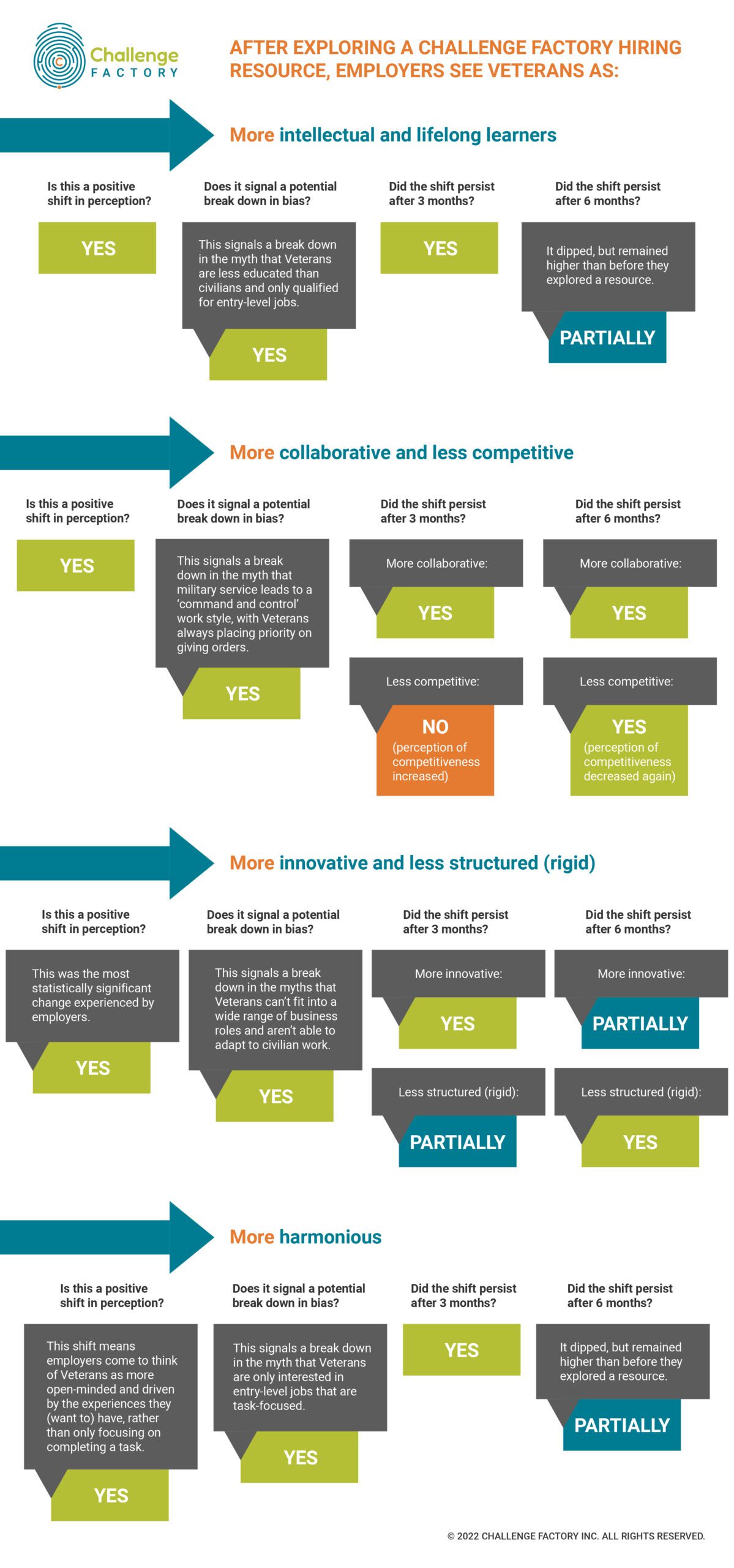Quality employer-focused education can lead to positive Veteran hiring outcomes and stronger overall recruitment and retention practices.
Challenge Factory created three free resources that are designed to help employers find, hire, and retain Veterans—and understand why they should want to:
- The Canadian Guide to Hiring Veterans
- MasterClass in Hiring: Tap into the Hidden Talent Pool of Canada’s Veterans
- Hidden Talent: A Challenge Factory Podcast
Not satisfied to only create novel and innovative resources, Challenge Factory set out to measure the impact these resources had on a core user: employers.
We wanted our resources to challenge employer bias about the Veteran population. Over six months, the resources shifted employers’ perceptions about Veterans in ways that were positive and in the direction we had intended. There was some backsliding at times, but never to where their perceptions had started before exploring our resources.
Check out the infographic below for a summary of the perception shifts experienced by employers and their persistence over six months.
Below the infographic, we explore the changes that employers made to their hiring practices, hear from employers in their own words, and offer five recommendations that Veteran-serving organizations will find useful in their own work.
Employers also made changes to their hiring practices after exploring Challenge Factory’s resources
Almost all judgment calls about culture fit—whether an employer thinks a Veteran will work well in their organization—are made based on observed behaviours during interviews and other job application interactions.
But the Veteran characteristics in the infographic are driving forces, which are not observable. These are the motivators and values that employers think will drive Veterans in workplaces.
The infographic shows that employers learned not only about how Veterans actually work, breaking down potential biases that might make them overlook Veterans as talented hires, but also what will engage Veterans in civilian workplaces.
“I’m thinking about ways to apply [what I learned] in my current role,” said one HR manager from British Columbia, “and how to share the knowledge and insight gained with others.”
Employee engagement is fundamentally about the relationship between employee, the work they do, and their organization. By exploring Challenge Factory’s resources, employers began to see Veterans as motivated by or placing value on:
- lifelong learning (the pursuit of new knowledge and skills)
- work that challenges them to be innovative and flexible in their critical thinking and problem solving
- collaboration, teamwork, and relationship building
- appreciating overall experiences and how different aspects of work tie together


In addition to measuring the shifts in perception experienced by employers, we also tracked the changes they made to their hiring practices. There were many.
Immediately after exploring a resource:
- 58 percent of employers said they planned to change or adapt their approach to interviewing
- 62 percent planned to create or update an onboarding process
- 42 percent planned to showcase themselves as a Veteran Ready organization for recruitment purposes
“[The Canadian Guide to Hiring Veterans made me feel] more knowledgeable and able to move ahead with looking for suitable Veteran candidates,” said an HR manager from Ontario.
A podcast listener from Alberta said, “I will investigate more into this possibility [of hiring Veterans].”
Three months after exploring a resource:
- 55 percent of employers had changed how they attract and seek out talent, including 14 percent who showcased themselves as a Veteran Ready organization
- 36 percent upgraded their onboarding process
- 27 percent adapted their approach to interviewing
“Veterans aren’t always great at describing their skills,” explained a MasterClass learner from Ontario when asked what she remembered three months later. “They may use different terminology than people who have never served. An employer should ask follow-up questions to get more information.”
After another three months had passed:
- An additional 43 percent of employers had changed how they attract and seek out talent, including 19 percent who had showcased themselves as a Veteran Ready organization
- 34 percent upgraded their onboarding process, including 5 percent who created a process from scratch
- 19 percent adapted their approach to interviewing
“I primarily remember a section [of the Guide] to help identify and overcome the language barrier that can exist between military and civilian life,” said a New Brunswick manager whose organization hired a Veteran. “It seemed helpful, particularly when identifying outcomes and discussing check-ins, reporting, and evaluations.”
A second employer in New Brunswick said, “[The podcast] brings to light what a retired service member brings to the table in terms of capability.” His organization hired six Veterans over six months.
At the end of six months, our study participants had hired 205 people, of which 25 were Veterans.
What does this mean for Veteran-serving organizations? 5 recommendations


But Veteran-serving organizations can also help Veterans by creating supports that focus on the other side of the interview table.
Both employer perceptions and practices can be shifted in ways that impact Veterans positively. The most common changes that employers made to their practices were related to how they recruit, interview, and onboard. They responded enthusiastically to practical tools that make their HR work easier.
Here are five recommendations to increase the likelihood that employer-focused tools will lead to positive Veteran hiring outcomes:
How did we collect data?
Over six months, the business owners, organizational leaders, and hiring managers who participated in our study completed four online surveys:
- Survey 1: Right before they began exploring their hiring resource of choice
- Survey 2: Right after they finished exploring a resource
- Survey 3: Three months after initially exploring a resource
- Survey 4: Six months after exploring a resource


